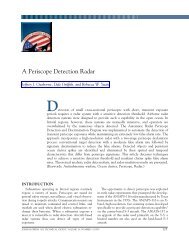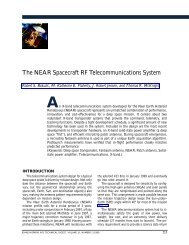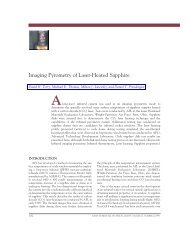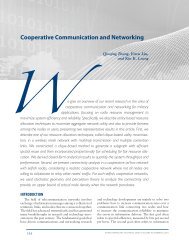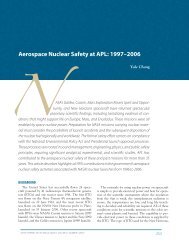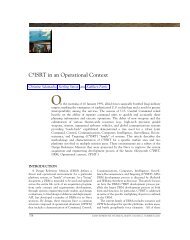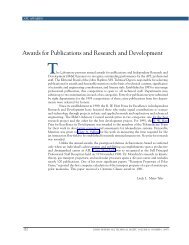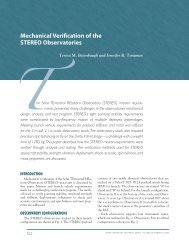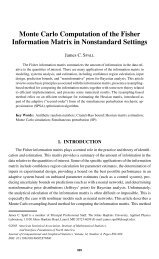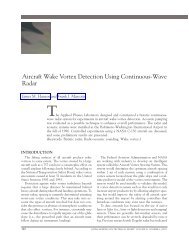Tomahawk Deconfliction - The Johns Hopkins University Applied ...
Tomahawk Deconfliction - The Johns Hopkins University Applied ...
Tomahawk Deconfliction - The Johns Hopkins University Applied ...
You also want an ePaper? Increase the reach of your titles
YUMPU automatically turns print PDFs into web optimized ePapers that Google loves.
A. F. POLLACK, R. C. FERGUSON, AND A. K. CHRYSOSTOMOU<br />
scenarios, the probability of hit by a heavy fragment is<br />
less than 0.005 for missile separation times greater than<br />
about 1.2 s.<br />
Overall, the probability of a missile being hit by<br />
debris from a previous missile impact is small. <strong>The</strong><br />
conclusions of this analysis indicate that terminal fratricide<br />
is not a concern for TOT separations greater<br />
than 3 s, a relatively small separation in comparison<br />
with variations in firing time and missile speed.<br />
En Route Interference Analysis<br />
Characterization of potential missile interference<br />
suggested that any time missiles were supposed to be in<br />
the same place at approximately the same time there<br />
was the potential for a collision. Since many missiles<br />
can share the same basic route to a single target or a<br />
set of targets, an analysis of the probability of collision<br />
along the flight path was necessary. <strong>The</strong> basic probability<br />
of en route collision was calculated in two parts:<br />
What is the probability that two missiles will pass, and<br />
what is the probability that two passing missiles will<br />
collide?<br />
<strong>The</strong> probability that missiles will pass depends on<br />
the missiles’ abilities to control their speeds. Each<br />
missile has a commanded speed; however, the actual<br />
speed flown by the missiles may vary. Two missiles will<br />
pass if the difference between their speeds is large<br />
enough. For missiles without TOT control, this speed<br />
difference can be represented by a Gaussian distribution<br />
with a mean of 0 and a standard deviation of<br />
2 speed , where speed is the standard deviation for an<br />
individual missile’s speed. This standard deviation is<br />
driven by variations in the missile’s air data system.<br />
Using this distribution, the probability of passing is the<br />
probability that the difference in missile speed will<br />
exceed some critical value. <strong>The</strong> critical value is determined<br />
by the initial missile separation and the nominal<br />
missile speed. <strong>The</strong> addition of TOT control to a mission<br />
changes the probability of passing. In effect, TOT<br />
control calibrates the missile speed at each waypoint,<br />
or turning point, eliminating the effects of the air data<br />
system variations. <strong>The</strong> probability of passing is significantly<br />
lower for missiles with unique TOT assignments<br />
that arrive on the common path in order; however,<br />
missiles that arrive out of order have a probability of<br />
passing that is close to 1 because the system will attempt<br />
to force a pass.<br />
<strong>The</strong> probability of collision while passing depends<br />
on the navigational accuracy of the missiles. If two<br />
missiles are flying along a common route and they pass,<br />
the difference in their relative accuracy determines<br />
whether they will collide. <strong>The</strong>se differences arise<br />
through a combination of guidance and control variations,<br />
GPS errors, and altimeter performance issues. 2,3<br />
As was the case for the speed distribution, these<br />
differences in missile position can be expressed as Gaussian<br />
distributions. A collision will occur if the differences<br />
between the missile locations in both the crosstrack<br />
and altitude dimensions are small enough. <strong>The</strong><br />
critical values for cross-track and altitude collisions<br />
must account for missile size, potential aerodynamic<br />
interference, and noninstantaneous passing. <strong>The</strong>se factors<br />
define the interference zones shown in Fig. 3; note<br />
that actual physical contact is not necessary for a<br />
collision to occur.<br />
Combining these results for the probability of passing<br />
and the probability of collision while passing produces<br />
a quantitative closed-form expression for the<br />
probability of two missiles without TOT control<br />
colliding (see Table 1). As demonstrated in every operational<br />
use of <strong>Tomahawk</strong>, more than two missiles may<br />
share a common route. APL built upon the two-missile<br />
equation to allow for analysis of an N-missile<br />
scenario—some number N of missiles flying a common<br />
route segment with an initial time separation of<br />
seconds between arrivals at the common route. <strong>The</strong><br />
N-missile probability of collision refers to the probability<br />
of at least one collision occurring.<br />
In developing the N-missile equation, the key observations<br />
are that every possible pair of missiles has<br />
some probability of collision, and the probability of at<br />
least one collision is simply 1 minus the probability that<br />
none of the missiles collide. Let p() represent the twomissile<br />
probability of collision for missiles initially<br />
spaced seconds apart. For the three-missile case, no<br />
collision will occur if missiles 1 and 2 do not collide<br />
Figure 3. Missile collision examples. Missile size, potential aerodynamic<br />
interference, and noninstantaneous passing define interference<br />
zones; actual physical contact is not necessary for a<br />
collision to occur.<br />
82 JOHNS HOPKINS APL TECHNICAL DIGEST, VOLUME 18, NUMBER 1 (1997)



